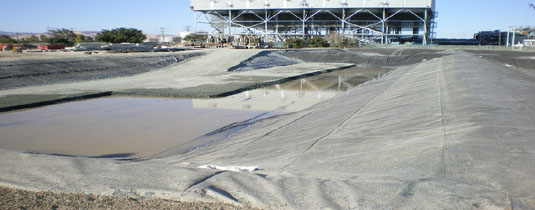
When it comes to lining a pond, the first and more popular option is a flexible liner made from Reinforced Polyethylene, Reinforced Polypropylene, CSPE, PVC or EPDM Rubber. There are other cheaper materials available; however for the purpose of building a lasting pond, it is advisable to use one of these flexible materials.
Reinforced Polyethylene (RPE) Liners
Reinforced polyethylene liners are generally considered the most durable liners available. In many cases, RPE liners don’t require a protective underlayment because of their higher tensile strength. Another advantage of reinforced polyethylene is they can be produced in very large sizes because of their light weight. However, a possible disadvantage to a RPE liner is that the material is slightly stiffer to work with which is only a problem if the pond has a lot of sharp protrusions, bends or corners or pipe penetrations.
Reinforced Polypropylene (RPP) Liners
Reinforced polypropylene liners are generally used for potable water applications. RPP can be easily box-welded into 3D shapes. Box-welding is the process of taking a flat liner and creating a 3D shaped box through the process of heat welding the seams. The main advantage of box-welding is that all the corners are nice and clean with no folds or wrinkles. If you’ve ever worked with a flat liner like EPDM rubber and tried to bend it around corners and ledges, you’ll know that you will never get it completely flat. RPP is the preferred material if a pond has pipe penetrations. It also has an extremely long life-span.
Chlorosulfonated Polyethylene (CSPE) Liners
Chlorosulfonated Polyethylene liners are geomembranes formerly known as Hypalon. CSPE or HypaFlex is a high-performance material designed for long-term applications, including floating covers and exposed liners. CSPE provides truly outstanding UV protection and long-term performance. HypaFlex is backed with an industry-leading 30-year weathering warranty.
PVC Liners
PVC liners are usually the least expensive option compared to other flexible liner materials, but their biggest downside is their lack of UV stability. What that means is that the pond liner must be completely buried with no direct sunlight contact; otherwise, the liner will begin to break down, shortening the life span.
EPDM or Rubber Liners
EPDM rubber liners are quite heavy. They are typically quite UV resistant which is a definite plus over some PVC liners. As a fishpond liner, EPDM is a good choice due to the lack of plasticizers in the liner. It is also possible to join two or more sheets together with some pond liner tape. In the case of large pond liners, it is often essential to combine multiple sheets to create a liner in the desired shape and size. Because rubber is so much heavier than material mentioned above, it is often more difficult to find and ship large pieces of EPDM due to weight concerns. If you need a large piece, it might be better to go with an RPE liner since it’s stronger, lighter and more cost effective.
CONTACT US 800-423-2380 FOR ASSISTANCE IN SELECTING THE MATERIAL THAT IS RIGHT FOR YOUR JOB.
